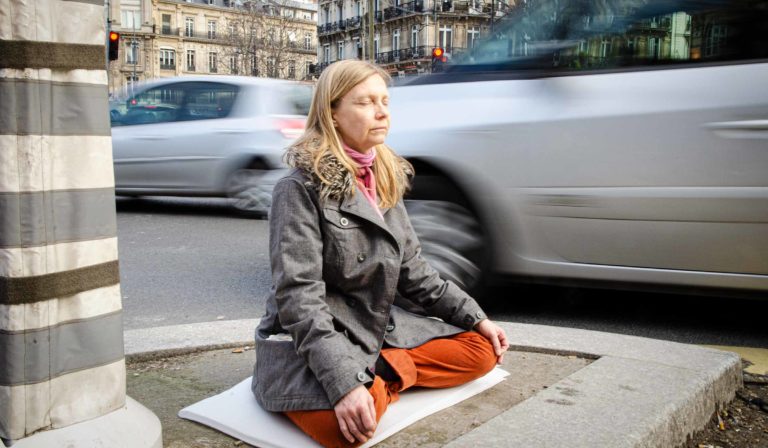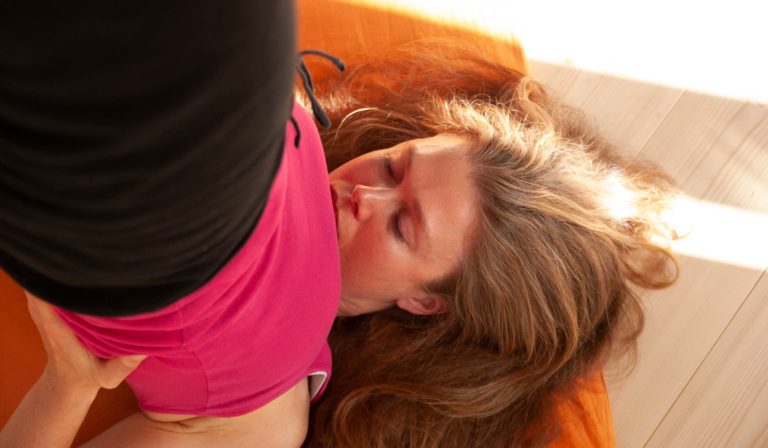This is a complete guide to yogic intestinal cleansing, shankhaprakshalana. It is a purification method that you do by drinking saltwater and performing five simple yoga exercises. In this post, you will learn everything you need to know about benefits and precations. You will also get detailed instructions on how to do shankhaprakshalana on your own safely.
Origins of shankhaprakshalana
There is a group of yogic purifications processes called dhauti. Dhauti techniques aim at cleansing the digestive tract in its entire length, and there are several different methods. The Gheranda Samhita, a Sanskrit text on yoga, describes Varisara Dhauti that cleanses the intestines with water. Swami Satyananda promoted an approach to Varisara Dhauti called Shankprakshalana. It has become a mainstay of dhauti practice in modern yoga.
Practise overview
You do shankhaprakshalana by drinking salt water and doing five easy yoga exercises. Three to four hours is usually enough to complete the cleansing itself. In addition, you must fast during the afternoon and evening before and follow a special diet for ten days afterwards.
The entire procedure includes the following elements :
- Fasting for half a day
- The drinking phase
- Kunjal and neti
- Rest
- Eating a special rice porridge with clarified butter
- Ten days of a special diet
Can you do shankhaprakshalana on your own?
I recommend you practice this method in a group under the guidance of an expert teacher. At least the first time you do it. However, if you can’t find a guide, you might set out to practice without one. Therefore I decided to write this article to help you practice intestinal cleansing as comfortably and efficiently as possible. You will benefit from my 20 years of experience with this method that I have taught to hundreds of people.
I have an advice for you and I strongly suggest you take it. If you set out to do shankhaparakshalana on your own, take care to prepare your session in advance and follow my instructions meticulously.
Benefits of intestinal cleansing
So what results can you expect from intestinal cleansing? As I will describe, this method has positive implications on many levels.
Many of my yoga students say that it gives them a general sensation of calm and lightness and that they feel charged with energy afterwards.
On a physical level, this cleansing alleviates all kinds of ailments in the digestive tract like gas, constipation and acidity. Shankhaprakshalana can also be part of a yogic approach to curing type two diabetes. The process will also make your senses more sensitive, making you more conscious of what you eat. In that way, the method can help you stay healthy and even lose weight by naturally choosing the food that your body needs.
The practice can also make you more flexible, which is welcome for asana practitioners. Furthermore, your skin’s health depends on your digestive system. This cleansing can relieve skin problems such as rashes, eczema and pimples.
Some participants report changes on the emotional plane. During the cleansing, strong emotions such as anger and sadness can surface and be cleaned out of your system. The intestines are packed with neurons (just as many as in the spinal cord). Scientists have discovered that this second brain plays a role in emotional regulation.
Because of all these benefits, we use shankhaprakshalana during yoga retreats to prepare for high-intensity practices. After shank, people are more calm and receptive. They can more easily sit still for long meditations, and it’s easier for them to integrate the effects.
Contraindications and precautions
If you are suffering from any medical condition or taking medication, consult a medical professional before doing shankhaprakshalana on your own. Here below are my thoughts on ailments that are known to impact this method.
Severe constipation
In case of severe constipation, I don’t recommend shankhaprakshalana. In that case, start by practising yoga and meditation with my recordings here on Forceful Tranquility. My long and deep delving sessions will positively impact your autonomous nervous system that regulates digestion. Once your condition has improved so that transit is more frequent and regular, you can proceed to the cleanse.
Diabetes
Shankhaprakshalana is good for diabetics. However, they should be aware that it will impact the amount of insulin they need to inject and be ready to modify the dose accordingly.
Allergic Angioedema
If you have previously suffered from allergic angioedema, you must consult a medical professional before attempting intestinal cleansing. The reason is that the cleansing can expel allergens stored in your body and retrigger your previous reaction.
What about high blood pressure?
People suffering from high blood pressure should keep their intake of salt low. But during the intestinal cleansing, you drink a considerable amount of saltwater. Therefore it would seem logical to advise against this intestinal cleansing. However, since all or nearly all the water you drink will pass through your digestive system without being absorbed, the salt won’t be a problem.
Is there a risk of water poisoning?
Consuming excessive amounts of drinking water can lead to a potentially fatal disturbance in brain functions. The reason is that the normal balance of electrolytes in the body gets pushed outside safe limits. Severe water poisoning is rare but has happened, for example, during water drinking contests.
During shankhaprakshalana, there is no risk of water poisoning. The reason is simple: because of the salt, the water never gets absorbed by the intestines.
Pregnancy
In the book Asana Pranayama Mudra Bandha, Swami Satyananda (or rather those who wrote the book for him) states that pregnancy is a counterindication for intestinal cleansing. I think not. Pregnant women are perfectly capable of benefitting from the method. Since pregnancy often slows down transit, it can be a welcome relief.
However, doing shankhaprakshalana on your own requires that you have some courage. Not the least if you are carrying a child.
Exercises for shankhaprakshalana
These are the five exercises you will be doing during the cleansing. I suggest you study them and learn them in advance so that you don’t need to use your energy on that the day of your shank. The excercises must be done in the order I give here below.
1. Tadasana
The first excecice is tadasana, the palm tree pose. Stand with your feet together. Interlace your fingers with the palms of your hands turned downwards. Raise your arms above your head, looking upwards, breath in and come upon the tips of your toes. Hold your breath and stay for as long as you can. Then breathe out, come down on your heels, lower your arms and let your arms hang along your sides.
Repeat tadasana three times.
If you find it challenging to maintain balance standing still in the pose, you can walk around with small steps.
2. Tiryaki tadasana
Stand with your feet wide apart. Interlace your fingers and turn your palms downwards. Then, raise your arms above your head and look upwards. While breathing freely, sway your arms and your upper body from side to side.
Repeat tiryaki tadasana eight times to each side.
3. Kati chakrasana
For kati chakrasana, or the standing dynamic spinal twist, stand with your feet wide apart and your arms relaxed. With normal breath, turn your head and your whole upper body to one side. Turn to the other side. Twist from side to side so that your relaxed arms start swinging. Twist fast enough that your arms hit your body; the forearm in front of you will hit your shoulder, the one behind will hit the small of your back.
Swing eight times to each side.
4. Teriyaki bhujangasana
Lay down on your belly. Place your hand on the floor and straighten your arms, pushing your upper body upwards. Twist your head to the right and look at your left heel. Then twist your head to the left and look at your right heel. Let your body breathe normally during the exercise.
Repeat eight times to each side.
5. Udarakarshanasana
Sit in the squatting pose with the hand on your knees. Breathe normally. Bring your right knee down to the floor in front of you. Using your hand, push your left knee to the right. Simultaneously twist your upper body to the left. Try to exert a slight pressure on your abdomen with your left thigh. Now do it to the other side.
Repeat a total of eight times to each side.
Prepare your equipement
Now that you have learnt the excecises it is time to look at what equipement you need. Make sure that you have everything in place the day before your session.
- Big glass for drinking (25cl – 30cl)
- Waterboiler or stove to heat the water
- Stove and two casseroles for the kitcheree
- Primary recipient to hold warm saltwater
- A second recipient for cold saltwater
- Measuring cup to measure the water
- Kitchen scale to weigh the salt
- Pen and paper
Prepare your ingredients
Also get the ingredients you will need for the cleansing itself as well as for the first meal that you will enjoy (well, not everybody loves it) when you are done.
For the water:
- Potable water
- Salt (ordinary table salt)
For your first meal:
- Red lentils (30g)
- Rice (100g)
- Clarified butter, also called ghee (or olive oil for vegans)
Pay special attention to the clarified butter, it needs to be ready the day before since you won’t have energy for it on the day of the session. If you don’t want to make it yourself you can buy it ready made.
Step by step instructions for shankhaprakshalana
On the day of the intestinal cleansing I advice you to start early. Eight in the morning is excellent. That way you will have finished the whole process and ready for lunch at usual lunch hour.
What to do the day before
The day before the intestinal cleansing, you will start preparing your body to ensure that it will be as easy as possible to make the water pass through. Have a regular lunch but skip dinner altogether and don’t snack. Having a piece of fruit and some herbal tea in the evening is fine.
Make sure to go to bed early to have a good nights sleep.
Have no drinking water in the morning
When you wake up, it is crucial not to eat anything whatsoever. In addition, don’t drink any water. Any water you drink at this point could interfere with the salt balance once you start taking saltwater.
Instructions for the drinking phase
Start boiling your water and get yourself ready to start the cleansing. Prepare at least one litre of water at a time to not have to boil new water between every glass. Add exactly 9 grams of salt to one litre of water. If you do that you will get a solution with 0,9% salt. That is physiological saltwater that your intestines won’t absorb. Use your kitchen scale to weigh the salt.
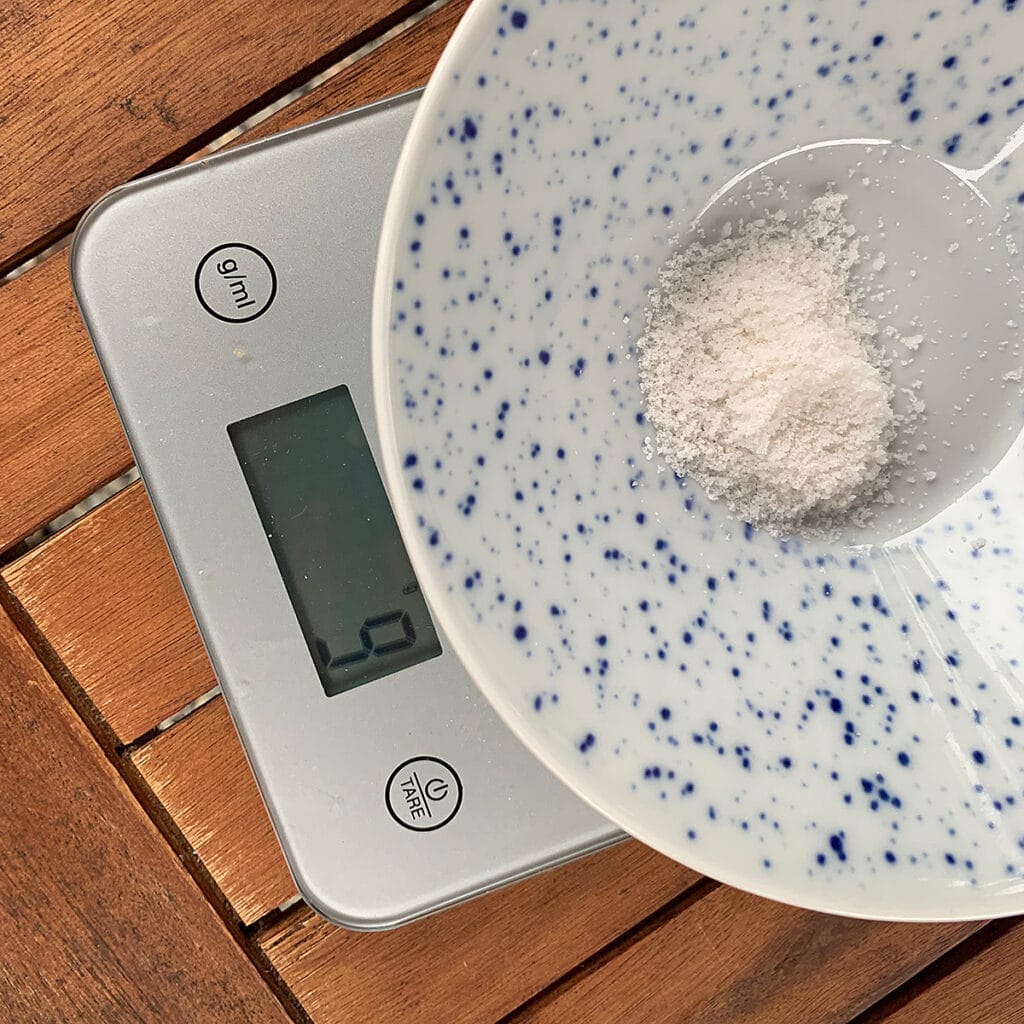
Drink the water as hot as you can without burning your mouth. Warm water will have a relaxing effect on your belly and make the water pass faster. If your water is too hot, use a cold saltwater solution that I suggest you prepare to dilute the warm water just enough to be acceptable to drink.
Drink your water without hesitation at a relatively quick pace. You might enjoy the taste of the water. Some people say it is like drinking bouillon. Others find it quite disagreeable. If you do, don’t worry about it. You don’t do it for the taste.
The advantage of drinking at a swift pace is that the cleansing will be over sooner. Given the amount you will drink, it will take you at the very least a few hours to finish the drinking phase. If you are a slow drinker, that time could be much longer. In that case, as you get more and more tired, it will be increasingly more challenging to continue.
After your first glass, it is time to do the five easy yoga exercises as I have described them. Then drink your next glass and do the exercises once more. Go on alternating drinking and exercise. After each glass, make a mark on your paper to track how much you have had. Otherwise, it will quickly become hard to remember.
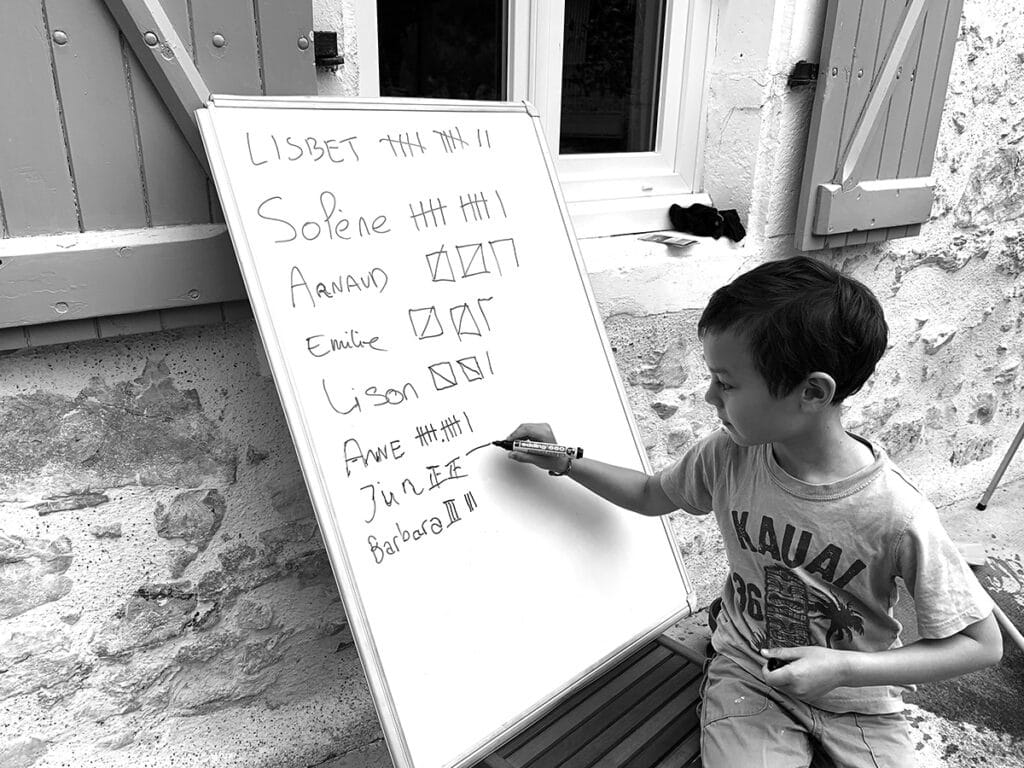
How to relate to emotions and mood swings
As you drink, you can pass through different emotional states. For example, it is not uncommon to feel both enthusiasm and sadness. Welcome any emotion, but don’t delve into them. Instead, stay focused on drinking at a steady rhythm.
Don’t sit or lie down
To help the water pass through the intestines, I advise you not to sit or lie down during the drinking phase. Instead, move around. If you have music which is a good idea, you may even dance. Should you need to rest, in that case, sit in the squatting pose. The squatting pose is the standard toilet pose in many countries and stimulates evacuation of the bowels.
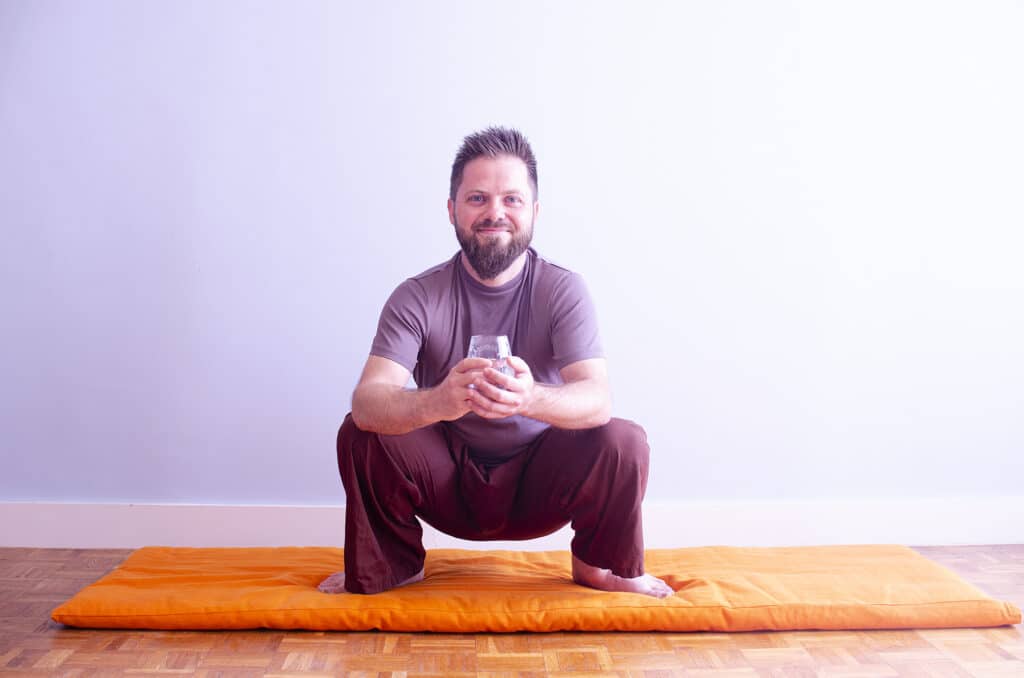
Go easy with the toilet paper
Now while doing the intestinal cleansing, you are going to go to the toilet a lot. Therefore, you need to be gentle when wiping your behind, or your anus could get sore.
Don’t drink ordinary water
It is crucial not to drink any ordinary water during the cleansing. That would change the salt balance and could make you start absorbing the water.
When to go to the toilet the first time
I recommend you to wait before going to the toilet the first time. It is good to drink at least six glasses, if possible more, before your first visit to build up some pressure in the intestines. After the first visit, you can go to the toilet whenever you feel the need.
When to stop drinking
When you go to the toilet, you will first empty an ordinary stool. Then there will be water mixed with solids, and then the water will be progressively clearer. However, the water will always have a yellowish colour. That comes from the bile, and no matter how much you drink, it won’t disappear.
Continue drinking until you have had a minimum of 16 glasses or when the water is free from particles. That typically happens between 16 and 20 glasses. There is no need to be a perfectionist. Going beyond 25 glasses serves no purpous.
How to tackle problems
Two relatively common issues might arise, and you should be prepared for them.
Vomiting
The first problem is that you could vomit during the drinking phase. At the end of your session, when you reach kunjal, you are going to induce vomiting. However, during the drinking phase, the water is meant to pass through your intestines.
There are two reasons for vomiting. The most common one is that you have trouble getting the water beyond your stomach fast enough. As the belly gets overfilled, the vomiting reflex is triggered. The remedy is to drink half-glasses instead of full ones and do the palm pose (tadasana) five times instead of three. If that doesn’t help, go through all exercises twice after each half glass.
The second reason for vomiting is that the taste of the water triggers the vomiting reflex. In that case, you will simply have to change your attitude towards the taste. Try thinking of the water as a soup. After all, it is not that different.
No water is coming through
The second common problem during shankhaprakshalana is that it can take some time for the water to come through. If you have had 10-12 glasses and not yet been to the toilet, you might wonder if there is an issue. Though most people will go to the bathroom before ten glasses, others can need much more water.
Don’t worry. The water will eventually make its way and come out. Since you are drinking physiological salt water, your body won’t absorb any of it. The proof of that is that you don’t need to urinate much.
If you come to a point where it starts feeling uncomfortable to hold the water you have been drinking. Then start doing the exercises twice between each glass. In addition, add pawanamuktasana as the last exercise in your series.
Do pawanamuktasana laying down on the floor and synchronise the movements with the breath. While breathing in flex your right leg, interlace your fingers around you knee and gently pull your thight towards your belly. Breath out and raise your head, touching your knee with your forehead. Hold your breath out and come back down on your back with your legs straight.
Next repeat the same procedure with your left leg and finally with both legs at the same time. Go trough the whole cycle three times.
Take the time to learn pawanamuktasana in advance if you don’t already know it.
Pawanamuktasana is a yoga excercie. Not to confuse with the pawanamuktasana series that is a whole programme of yoga excercices.
If you reach a point where you feel like you can’t keep on drinking, then go on doing the exercises only. After each time, spend a moment sitting on the toilet in the squatting pose (possible even on a western toilet). While sitting there, calmly hold your breath for as long as you can. Repeat a few times.
Rest assured that eventually, the water will make its way. When that happens, it will be a welcome relief.
You are urinating a lot
There is a third issue that should not happen. If you start urinating a lot, that means your water doesn’t have the right salt concentration. That is a severe issue. If you follow the instruction in this post, it won’t happen.
However, if it should happen, in that case, stop the cleansing. And go directly to the resting phase. After resting, follow the same steps as if you had completed the whole cleanse.
Kunjal
Once your water is clear and without particles, it is time to finish the drinking phase and proceed to kunjal, yogic vomiting. Now make 1,5 litres of a lukewarm saltwater mixture, still with 0,9% salt.
The idea is to drink as much as you can of this water as quickly as possible and then vomit. The faster you drink, the easier you will vomit. If you don’t manage to vomit spontaneously, use your fingers to stimulate your throat around the uvula to trigger the vomiting reflex.
You might be surprised by how much water you can drink before throwing up. When I did the intestinal cleansing the first time, I felt like I would vomit after each mouthful of water. But when I came to kunjal I swept a colossal salad bowl of water before I threw up.
Kunjal relaxes the stomach and induces general wellbeing. It is a nice way to end the drinking phase.
Nose cleansing (optional)
After kunjal it is excellent to do neti, nose cleansing if you have a neti pot.
Resting phase
Now it is time to lie down and have a rest. But before you do that, repeat the exercises once more. There might still be water left in your intestines, and it’s better to get it out now than that you need to go up while resing.
Set an alarm so that you will rest for precisely 45 minutes. During this time, stay warm and comfortable but take care not to sleep.
Your first meal – kitcheree and ghee
It is good if you have someone to prepare your meal for you while you are resting. You get the best result if you boil your rice and lentils separately and mix them at the end. If you cook the rice and lentils in the same casserole, the lentils will not as quickly get soft.
Count 100g of rice and 30g of lentils for one person. Boil the rice under a lid in about 4 dl of water and let the lentils simmer in 2dl of water until dissolved. Mix lentils and rice before serving and add several tablespoons of ghee.
Finish your kitcheree even though you might not feel like it. Giving your intestines this meal to work with now will allow them to get back to normal function quickly. If you skip this meal or eat only a little, it will take 3-5 days for your stomach to perform as usual.
Instructions for the rest of the day
At this point, you have finished the intestinal cleansing. However, there are special instructions for the rest of the day. The first is not to drink any water for another four hours. The reason is safety. Should you still have saltwater left in the intestines, your body might absorb it should you disturb the salt balance with drinking water.
In addition, when you start drinking normal water again, have only heated water for the remainder of the day. You don’t need to drink it hot, but it should be at least lukewarm.
For the remainder of the day, I encourage you to take it easy, all while staying active. Going for a walk or doing any other calm activity outdoors is perfect.
It is not uncommon to feel tired in the afternoon of the day after intestinal cleansing. But even in that case, stay active.
Ten-day diet after the intestinal cleansing
The day of the intestinal cleansing is day 0 in your ten-day diet. To benefit from all that water drinking, you need to respect this simple vegetarian diet. The post shankhaprakshalana diet ensures that the purification you have now initiated continues. During this time, cook using high-quality organic ingredients. Avoid canned food, frozen food and ready-made meals.
Prepare all your meals yourself since it is not easy to find food that corresponds to this diet in restaurants.
What can you eat and drink?
Vegetables
- Zucchini
- Aubergine
- Pumpkin
- Corn
- Spinach
However, don’t eat onions and garlic or leek.
Cabbage
- Cauliflower
- White cabbage
- Broccoli
- All other kinds of cabbage
Root vegetables
- Potatoes
- Carrots
- Root celery
- Parsnips
- Beetroots
- All other kinds of root vegetables
Legumes
- Lentils
- Chickpeas
- Haricot verts
- Adzuki beans
- Blackbeans
- Kidneybeans
- All other kinds of legums
Cereals
- Brown rice
- Quinoa
- Millet
- Full-grain wheat
However, go easy on refined grains such as pasta and white bread.
Drinks
- Water
- Sparkling water
- Soya milk (without added sweeteners)
- Herbal tea
Nut and grain pastes
You can have nut butter in moderate quantities.
- Peanut butter
- Almond butter
- Tahin
What to avoid:
- Coffé, the (black and green)
- Chocolate
- Alcohol
- Any kind of meat, fish and eggs
- Milk products
- Fruit and fruit juice
- Spices
- Honey and sugar
- Raw food (For example, salad or uncocked tomatoes.)
Cooking instructions
During the diet after shankhaprakshalana everything you eat should be boiled or steamed until it is soft. Avoid frying. Your meals should be natural, simple and easy to digest. Add no salt at all the first few days, and then add just a tiny bit. Avoid everything that excites the nervous system, including any spices. After the intestinal cleansing, your nervous system will be more sensitive, and your tastebuds will be super sharp. I promise that everything will taste more than you are used to.
This diet will make you aware of your food habits and can help you change them if you wish to. It is not a diet designed to lose weight though you might do that as a side effect.
You mustn’t break your diet early as it can result in problems such as stomach pain, diarrhoea, constipation or general discomfort.
Key takeaways
- Intestinal cleansing is a yogic purification process with many benefits, not the least for your digestive system.
- You get the most out of shankhaprakshalana when you use it to complement yoga and meditation practice.
- If you are capable of meticulously following the instructions in this pose, you can do it yourself.


